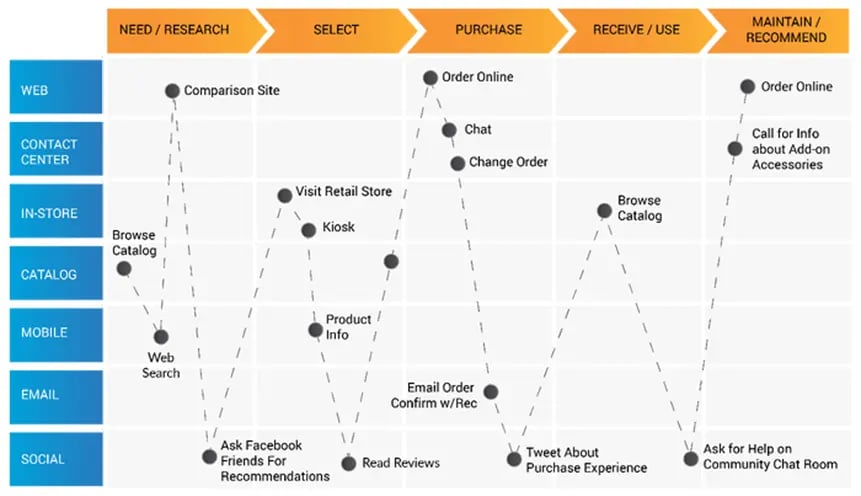Table of Content
TABLE OF CONTENTS

Organizations across industries understand the importance of Customer Experience and are making large investments, and rightly so, to offer an enhanced experience to their customers. Companies that lead in Customer Experience outperformed those farther behind by almost 80%. (The Total Economic Impact of Qualtrics CustomerXM, 2019) However, it’s hard to improve the customer experience without a clear understanding of their actual experience. Mapping out the customer journey is the first essential step a business must take to improve its overall customer experience.
What is Customer Journey Mapping?
Customer Journey Mapping is the process of defining and illustrating the steps customers go through while engaging with a company, whether it is an online experience, retail experience, customer service, or any combination of these. Customer journey mapping helps capture the customer’s behavior in a systematic, logical, and efficient way. Mapping is also a means to evaluate customer behavior, marketing programs, and brand campaigns.
 Customer touch-points across multi-channel end-to-end customer journey
Customer touch-points across multi-channel end-to-end customer journey
How does Mapping help?
- Mapping aids in better understanding the behavior of customers across multi-channels.
- Mapping is a better way of predicting and planning the future journey of a particular customer.
- Mapping plays a vital role in the customer experience strategy that will impact the overall marketing, sales and customer engagement
Customer journey mapping is essential to understand customer behavior and to engage with them effectively. It is important to remember that one cannot simply go with “gut feeling” or intuition when mapping. Businesses have to arrive at findings based on research that is backed by data and a visual display of results. Mapping requires a process, and it’s essential to clearly define the end goal of the journeys (purchase, investigation, lead generation, cross-sell, information capture, etc.) that are being mapped and what it needs to achieve. The overall process calls for a detailed understanding of the consumer and the company.
Customer Journey vs. Customer Experience
As with any term, Customer Journey is used to define everything from marketing campaigns, customer service interactions, or general contact planning. Customer Experience can also mean a variety of things to a variety of people. Both terms are often used interchangeably. However, though both are based on the same customer model, they are quite distinct. Customer journeys map the customer experience. “Customer Journey” is how a user progresses across various touchpoints before completing their journey. This data can provide insights into a company’s customer obstacles, opportunities, and market segmentation. “Customer experience” is how well the overall experience across the entire journey matches customer expectations. It is how a business engages with its customers and their perception of the effectiveness of that engagement, including any obstacles they are facing.
Customers Rule! The Right Approach to Customer Journey Mapping
Many companies and even consultants think that customer journeys can be designed sitting in a conference room, and the customers will just follow these journey maps. It’s actually the opposite. The customers are in charge, and it’s not practical to force them down a specific path. With correctly structured data, businesses should be able to look at the customers’ behavior online, interactions with customer service, interactions with the sales force, and other touchpoints to identify the customer journey from the data and not the other way around! Customers decide, and the data tells us what their journey looks like. It’s the marketers’ job to understand their path and enhance the customer experience through personalization. Deciding what the customer journey should be on a whiteboard without proper evidence and hoping the customers follow is a suboptimal, and maybe even naïve, way of thinking about the customer journey.
Common Pitfalls to Avoid While Mapping
Customer Journey Mapping can be a powerful tool, but its usefulness will be limited if the mapping exercise is not conducted effectively.
Insufficient scope and a narrow outlook
It’s difficult to correctly identify the customer journey if you’re only looking at a few channels. The website is a popular channel of interaction. For a digital company with no other medium but a website, that would be a good way to get started. However, most enterprises have multiple channels for customer interactions, and without studying all the channels and the manner of interactions, the mapping will end up being flawed. Mapping the customer journey by only considering customer service or marketing communications could lead to false assumptions and customer experience pitfalls.
Fail to focus on key segments and personas
Not all customers are the same. Enterprises have various customer segments - high, medium, and low-value customers, for example, and the customer journey needs to be defined for each segment individually. Marketers must identify what customers go through which journey, without which it would not be possible to personalize or enhance the experience.
Mapping based on assumptions
Organizations charting up the customer journey on a whiteboard based on assumptions without the proper data support is an ineffective way of journey mapping and is bound to fail. If the data is insufficient, it is worth spending some time gathering the necessary information. It’s better to get started on the right path, though delayed, than committing an expensive mistake.
Customer Journey Analytics
Gartner defines customer journey analytics as the process of tracking and analyzing how customers use combinations of channels to interact with an organization and covers all channels, present and future, that interface directly with customers. (Gartner Market Guide for Customer Journey Analytics, June 2016) Journey analytics analyzes data and generates actionable insights to optimize customer journeys and continuously measures the performance of CX initiatives. Journey Analytics can use data to discover the most significant opportunities and provide a comprehensive view of the customer journey. By identifying a customer’s journey in real time, marketers can help the customer complete the journey and influence them by presenting personalized offers.
Journey Analytics can provide insights on
- What percentage of customers take a particular path?
- How can businesses reduce churn in important journeys?
- What is the best time and the best channel to interact with the customer?
- What kind of customers take each path?
- How do marketers add value for each customer in a given context?
Customer centricity is the core of every successful business. As companies strive to meet customer demands, customer journey maps are critical to delivering on those demands. The better they understand their customers, the more likely they are to design products and services in tune with the customers’ needs, resulting in a positive customer experience. Having said that, it is important to note that the market changes, and so does the customer. Companies should constantly monitor and update their customer journey maps to reflect those changes for it to remain a powerful tool.
We at Mastech InfoTrellis, recently used journey mapping for a financial service company to identify the different paths customers take to churn, become higher-value customers, and become loyal customers. We tracked the different interactions, revenue, and customer segments at various points in time and key customer events across all digital and live channels. We tracked customer events like acquisition, time to hit certain revenue thresholds, decrease in revenue threshold, time to hit certain annual spend threshold, and time to become the highest value customer, which was considered a loyal customer. A marketing and service plan devised based on insights from the different journeys yielded very satisfying results -
- Double the retention rate
- Increased the number of high-value customers, which in turn increased revenue of that segment by 20x
- An overall increase in revenue by 16 million or 16x
Mastech InfoTrellis enables companies to create a customer experience that is intuitive and provides a personalized, engaged, and relevant experience through the entire customer journey. We help businesses increase sales revenue by creating better experiences and personalizing their journey with the right messages and offers based on purchase history.
Tags
Data Activation
Customer Experience Team
Customer experience that is intuitive and provides a personalized, engaged, and relevant experience through the entire customer journey.
-2.jpg?width=240&height=83&name=Menu-Banner%20(5)-2.jpg)
.jpg?width=240&height=83&name=Menu-Banner%20(8).jpg)

